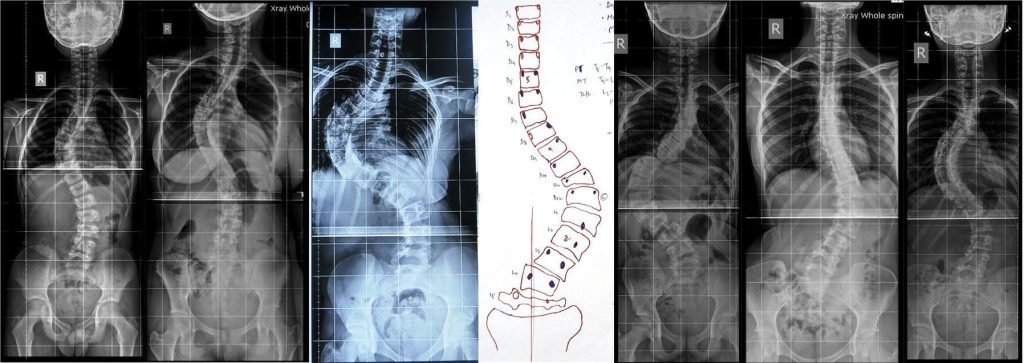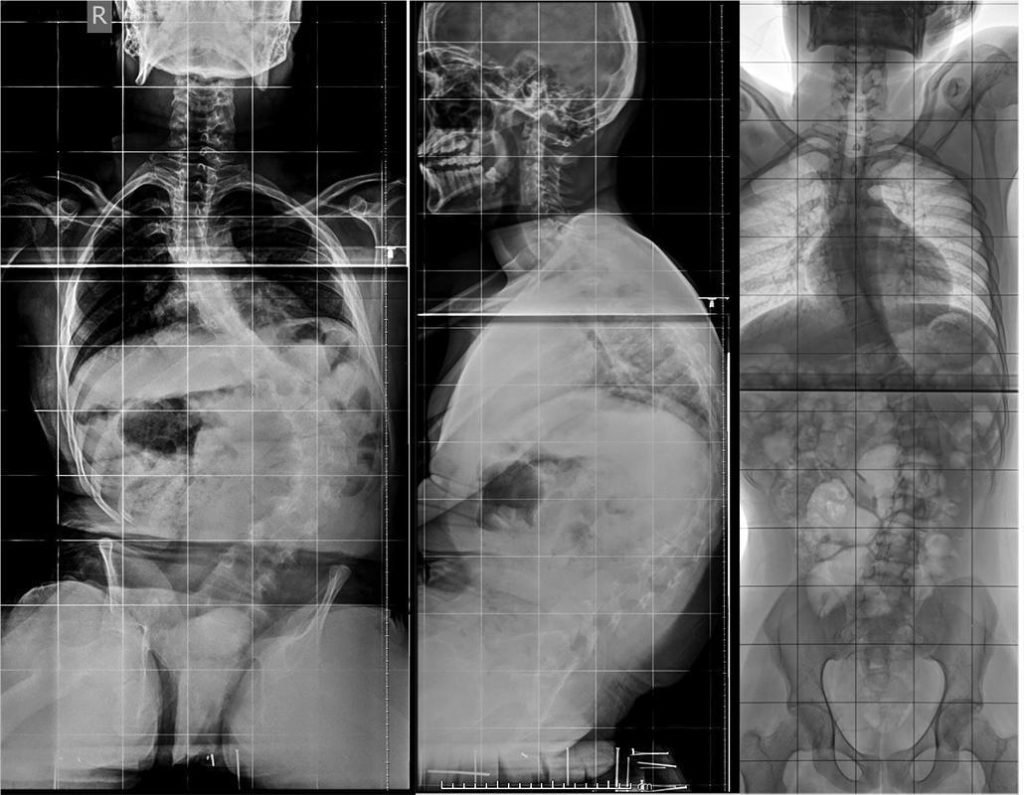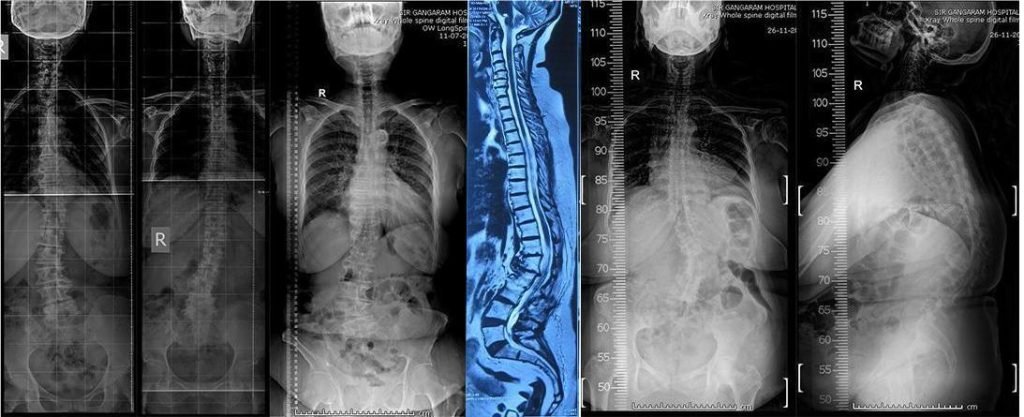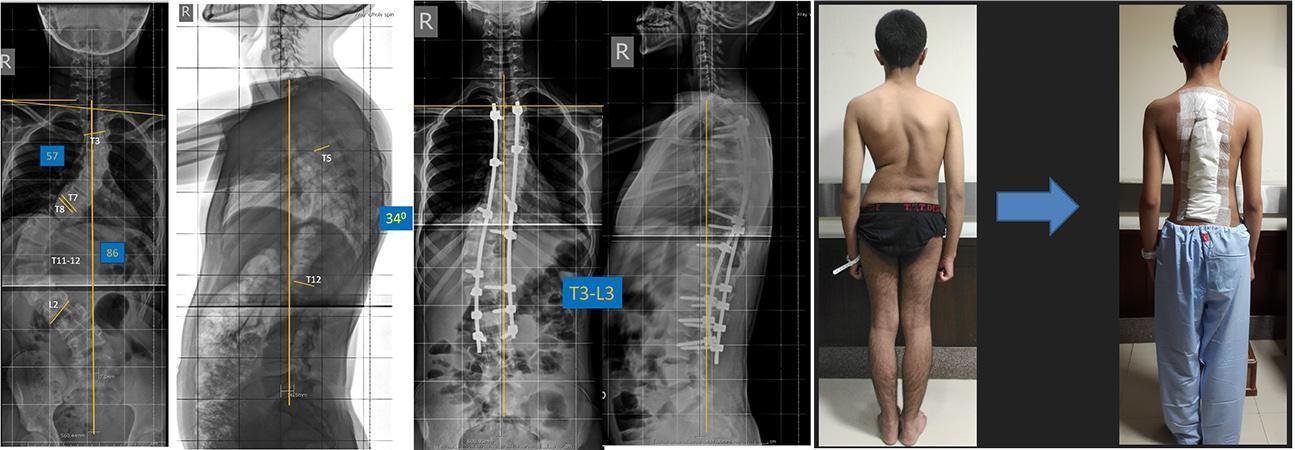


In some cases, scoliosis can progress to cause:
-
Back pain: This is more common in adults with degenerative scoliosis or severe curves.
-
Breathing difficulties: Severe scoliosis may reduce the space in the chest, affecting lung function.
-
Fatigue: Due to muscle strain from maintaining balance and posture.
Types of Scoliosis


2 Congenital Scoliosis
Congenital scoliosis is present at birth due to improper formation of the spine during pregnancy. Some of the vertebrae may be fused, or parts of them may be missing, which can cause an abnormal curve as a child grows. Early treatment is essential to manage this type effectively.

3 Neuromuscular Scoliosis
This type of scoliosis is related to underlying neuromuscular conditions, such as muscular dystrophy or cerebral palsy. Neuromuscular scoliosis occurs when muscles around the spine are weak or imbalanced, causing the spine to curve. Treatment often requires a specialized approach that considers both the scoliosis and the associated neuromuscular condition.

4 Degenerative Scoliosis
Degenerative scoliosis, also known as adult scoliosis, occurs later in life. It is often caused by age-related wear and tear on the spine, such as arthritis or disc degeneration. This type usually develops in the lower back and can cause pain or discomfort. Physical therapy, medications, or sometimes surgery may be needed to manage symptoms.

RISK FACTORS
-
Age: Scoliosis is most commonly diagnosed in children and teenagers, especially during the growth spurt around ages 10 to 15. The condition can also develop or worsen in older adults.
-
Gender: Girls are more likely than boys to develop a severe form of scoliosis, especially during their growth years.
-
Family History: If someone in your family has scoliosis, there may be an increased risk for developing it. In fact, up to 30% of people with scoliosis have a family member with the condition.
-
Certain Medical Conditions: Conditions like cerebral palsy, muscular dystrophy, and other neurological or muscular conditions can increase the risk of scoliosis. These conditions affect the muscles and nerves that support the spine.
-
Spinal Abnormalities: Congenital spine defects or problems with the development of the bones in the spine can increase the chances of developing scoliosis.
Step 1
Physical Examination
During the initial consultation, Dr. Acharya will ask about your medical history and perform a thorough physical exam. This includes checking for any noticeable signs of scoliosis, such as uneven shoulders, hips, or an abnormal posture. In some cases, the doctor may ask you to bend forward to better observe the spine’s curvature.
Step 2
Imaging Tests
If scoliosis is suspected, the next step is to confirm the diagnosis with imaging tests. X-rays are commonly used to measure the degree of curvature in the spine. In some cases, MRI or CT scans may also be recommended for more detailed images, especially if there is concern about nerve involvement.

Step 3
1 Non-Surgical Treatments
-
Observation and Monitoring: For mild cases, especially in children who are still growing, regular check-ups are recommended to monitor the curvature and ensure it doesn’t worsen.
-
Bracing: For moderate curves in growing children or teenagers, wearing a brace can help prevent the curve from worsening. Braces are not used to straighten the spine, but they help support and prevent further progression.

2 Surgical Treatments
In cases where the curve is severe or causing pain and other complications, surgery might be recommended. The most common surgery for scoliosis is called spinal fusion. This procedure helps straighten the spine and stops the curve from getting worse by fusing two or more vertebrae together.

FAQ
Is scoliosis painful?
In many cases, especially in children, scoliosis is not painful. However, adults with scoliosis may experience back pain or discomfort, particularly if the curve worsens or leads to other spine issues.
Can scoliosis get worse over time?
Yes, scoliosis can worsen, especially during growth spurts in children and teenagers. Regular monitoring is important to track any progression.
Can exercise or physical therapy help?
Yes, physical therapy can improve posture, strength, and flexibility, helping to reduce discomfort. However, it won’t reverse the curve.
Is scoliosis surgery safe?
Scoliosis surgery is generally safe and highly effective. Advances in surgical techniques allow for better correction with faster recovery. Dr. Shankar Acharya specializes in these procedures, ensuring excellent care for patients.
Can scoliosis be prevented?
Most cases of scoliosis cannot be prevented as the causes are often unknown. However, maintaining good posture and a healthy lifestyle can help support overall spine health.
Is scoliosis hereditary?
Yes, scoliosis can run in families. If a family member has scoliosis, it’s a good idea to watch for signs in children and teenagers.
Can I live a normal life with scoliosis?




